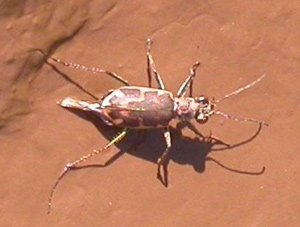Cicindela nevadica lincolniana, Salt Creek Tiger Beetle |
|---|
 This beetle is a member of the tiger beetle subfamily Cicindelinae. There are 4 genera and 119 species of tiger beetles in North America. Most species (94) are in the genus Cicindela. The Salt Creek tiger beetle is unique because it exists only in saline wetlands in the northern part of Lancaster County, Nebraska. Its entire life cycle is tied to the sloping, muddy banks of creeks and tributaries draining these wetlands. Females lay their eggs in the moist, salty soil of the creek banks. When an egg hatches, the larva uses its head to dig a burrow where it will spend the rest of its larval stage. The larva is predatory. It waits at the top of the burrow to ambush any small arthropod, grabbing the prey with large mandibles and pulling it into the burrow. Larvae are often subject to flooding and are more tolerant of anoxia than other insects. The larva probably overwinters as third (last) instar byplugging the burrow with mud. It is unknown whether Salt Creek tiger beetles have a 1 or 2 year life cycle. Either way, the larvae pupate in the burrow in spring, and emerge as early as the end of May or as late as mid-June. Adults are small metallic beetles with conspicuous mandibles. They are active during the day, roaming open wet soils in search of any arthropods smaller than they are. Tiger beetles in general have excellent vision and are capable of running and taking flight with unusual speed. The adult Salt Creek tiger beetle lives for about 5-6 weeks, disappearing by mid to late July. The Salt Creek tiger beetle faces a dilemma that is only too common. It is endemic to a very specialized rare habitat type that is being continuously destroyed by development. Historically, there were about 16,000 acres of saline wetland in the Lancaster County area and museum collections indicate that the beetle was once abundant. However, in 1999 it was estimated that 90% of the saline wetlands had succumbed to development and most of what remained had been degraded by silt deposition, grazing, and altered hydrology. Tiger beetles may also be harmed by insecticides, directly from local sprays or run-off, and indirectly from reduced prey availability or consumption of contaminated prey. Surveys from 1991 to 1999 have found beetles at only 5-8 sites, and total numbers have ranged from 115 individuals in 1993 to 637 in 1995. Populations have gradually declined since 1993, and only 271 individuals were found in 1999. The Salt Creek tiger beetle is now considered one of the rarest insects in the world, and further development around the city of Lincoln poses a constant threat to the remaining few populations. In March of 2000 the beetle was listed as an endangered species under the Nebraska Nongame and Endangered Species Conservation Act, which theoretically provides protection for the beetle on state and private lands through conservation programs and state agency consultation, and makes it illegal to take, possess, sell or transport the species. At the federal level, the U.S. Army Corp of Engineers permitting process under the Clean Water Act should regulate dredging and filling of wetlands and thus protect Salt Creek tiger beetle habitat. However, this program has been ineffective in controlling road and development projects that have destroyed or degraded tiger beetle habitat. The beetle has been a candidate for listing under the federal Endangered Species Act since 1994. However, the residents of Lancaster County appear to believe that it is better to strengthen local conservation efforts and avoid the economic impacts of federal involvement. In November-December 2001, the Mayor of Lincoln assembled a committee to discuss ways to protect the tiger beetle and preclude federal listing. In general, the committee recommended 1) research to determine specific habitat requirements and effects of human activity; 2) zoning regulations, easements, etc. to minimize further loss while research is conducted; 3) acquisition of land; 4) public education and outreach, emphasizing the need to balance economic concerns with conservation; 5) developing a recovery plan for the beetle. Since then, the City of Lincoln has purchased 61 acres containing 40 acres of saline wetland, and the Nebraska Game and Parks Commission is considering buying a 156-acre tract (to be discussed May 2004). Whether state and city conservation efforts will preclude federal listing is still unknown. Because of its dependence on a habitat that is nearly destroyed and impossible to replace, this beetle will never regain its historical abundance. Its continued survival depends on the protection of small, fragmented populations, and the stability of these populations is unknown. |
Resources:
|
Written by: S.J. Reilly, 2004 Updated 2008 |
Image credit: U.S. Fish and Wildlife Service |